NIL
Oregon NIL bill advances in state legislature; could conflict with House settlement
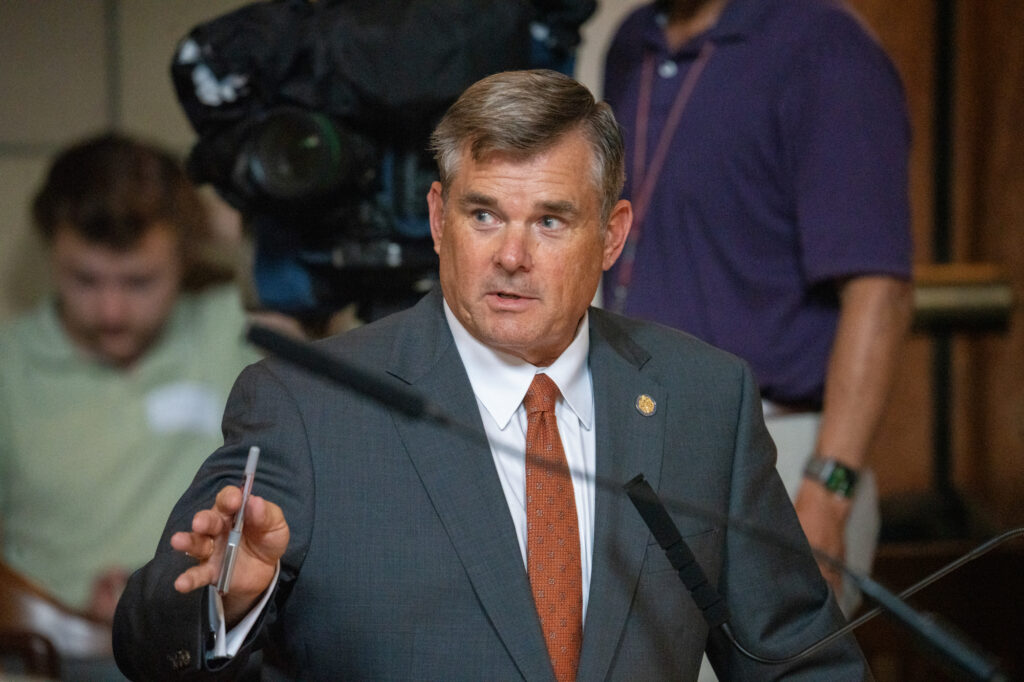


A bill that modifies existing Oregon law around student-athletes earning money from their Name, Image and Likeness (NIL) advanced in the state legislature last week.
On April 10, House Bill 3694 passed in the Oregon House with 46 votes in favor, nine against, and five not voting. It moves to the Senate chamber, where a first reading is scheduled for Monday.
HB 3694 has the backing of the University of Oregon and a letter of support from Oregon State student-athlete and U.S. Olympian Jade Carey. But OSU athletic director Scott Barnes and some outside legal experts have expressed skepticism over the bill’s potential conflict with the forthcoming House settlement, which seeks to provide universal standards for NIL distribution among NCAA member institutions.
“We’re trying to build infrastructure to create consistency and standards at a national level,” Barnes, who is part of the committee that helped craft proposed NIL standards, said last month. “Any variation of those standards limits the effectiveness of what we’re building. It’s not unlike past years with NIL where there is a patchwork of different state legislation, and the standards aren’t consistent, so you have different opportunities for different student-athletes instead of the same access and same opportunities.”
Critics of HB 3694 point out it could prevent the NCAA and conferences from enforcing limits on NIL payments — a key component of the House settlement, which would include a roughly $20.5 million NIL “salary cap” per school. Defending national champion Ohio State’s athletic director once claimed it spent that much on its 2024 football roster alone.
Schools like Oregon State say they won’t come close to the proposed cap, with multiple sources telling The Oregonian/OregonLive that the Beavers’ men’s basketball NIL budget was roughly $800,000 last season, and their roster was soon decimated in the transfer portal. But powerhouse institutions like Ohio State, Georgia and the Phil Knight-backed Oregon conceivably have more than enough capital to go beyond the cap if there was a legal basis to do so.
While none of those schools have publicly expressed a desire to skirt the House settlement rules — nor will they say so, considering every major institution is expected to sign on to the agreement — legal experts question whether the rules are even enforceable without the additional backing of federal legislation. Particularly with potentially conflicting state legislation popping up around the country.
“A federal bill coming alongside the settlement in a constructive way that creates synergy around correcting this out of control marketplace, that is crucial,” Barnes, also among the power brokers pushing federal legislators for a comprehensive NIL bill, said in March.
Back to the details of HB 3694. While a sentence about preventing limits on “institutions’ support of student athletes’ economic rights” has been removed from the Oregon bill’s staff summary, the latest version of the bill includes language that critics say could still conflict with the House settlement standards.
“A post-secondary institution of education or an athletic association, conference or organization with authority over intercollegiate sports may not … prohibit, prevent or restrict a student athlete from exercising [the student’s] economic rights,” the bill reads.
“An athletic association, conference or organization with authority over intercollegiate sports may not prohibit a post-secondary institution of education from identifying, facilitating, enabling or supporting opportunities for a current student athlete to exercise the student athlete’s [student’s] economic rights at the student athlete’s post-secondary institution of education,” it later says.
If a school is running up against the cap, and a student-athlete wishes to pursue a NIL deal that might put the school over the $20.5 million limit, would stopping that deal be a violation of the athlete’s “economic rights,” as described in HB 3694? And what if a school “identifies, facilitates and enables” a NIL deal, but the NCAA says no, citing the cap?
Those questions, industry sources and some NIL legal experts say, put the cap and potentially the settlement itself on shaky legal ground in states with legislation similar to HB 3694. Unless, of course, federal legislation addresses that issue and renders the conflict between states and the NCAA moot.
HB 3694 would also prevent the NCAA and conferences from accepting “a complaint, open(ing) an investigation or tak(ing) any other adverse action against a post-secondary institution of education or a student athlete as a result of a violation, or an alleged violation, of the rules or regulations of the athletic association, conference or organization related to a student athlete exercising [the student’s] economic rights.”
Critics worry that could create a scenario where, even if a school in Oregon did violate NIL rules including but not limited to the $20.5 million cap, there would be no mechanism of enforcement. Not only could the NCAA and conferences not investigate or take action against that school for such an alleged violation, they couldn’t even accept a complaint about it in the first place.
The chief sponsor of HB 3694, Rep. John Lively (D-Springfield), previously said the bill was amended so it would not “prevent student-athletes from participating in the (House) settlement or create compliance issues for institutions.”
Whether that rings true remains to be seen, and the debate itself could eventually be silenced by a sweeping, federal NIL bill that matches the House terms.
— Ryan Clarke covers college sports for The Oregonian/OregonLive. Reach him at RClarke@Oregonian.com or on Twitter/X: @RyanTClarke. Find him on Bluesky: @ryantclarke.bsky.social.
NIL
The Most Egregious Double Standard in Sports

In college football, one rule seems to always hold: When a player leverages his power, it’s a scandal. When a coach does the same thing, it’s just business as usual.
That dynamic is now playing out in the response to the decision of the longtime University of Mississippi coach Lane Kiffin to leave the team to become the new head coach at Louisiana State University. Kiffin led Ole Miss to a historic regular-season record of 11 wins and one loss, and the university is now poised to make its first-ever College Football Playoff appearance. The Rebels have a real chance of winning a national championship. LSU’s seven-year, $91 million offer was apparently enough to put all of that in jeopardy.
Imagine, for a moment, if a player had done any of the things Kiffin did as he secured his golden ticket to LSU. Imagine if a player had been playing footsie with two conference schools, as Kiffin did with LSU and the University of Florida after both programs fired their coaches in late October. Imagine if a player’s family had boarded a private jet and been given a personal tour of the city that’s home to the school courting his services—something Kiffin’s family reportedly did in Baton Rouge, Louisiana.
Actually, we don’t have to guess, because similar scenarios have played out. When the former University of Tennessee quarterback Nico Iamaleava transferred to UCLA this past spring after reportedly holding out from practice because he wanted more name, image, and likeness (NIL) compensation from Tennessee, his circumstance was used as an example of how player greed is ruining college football.
“If they wanna play holdout, they might as well play get-out,” Mario Cristobal, the University of Miami head coach, said at the time.
By contrast, while appearing on ESPN’s morning show Get Up last week, the former New York Jets coach Rex Ryan said: “I don’t blame Lane Kiffin for going after it. Look at the landscape of college football, which I think is absolutely abysmal—not just the calendar, but the fact you let kids bail all the time. You know what? I’m going to make more money if I go to this place. What is the difference?”
The difference is that during this season alone, fired college coaches have cost schools nearly $200 million in buyout money, yet nobody is suggesting any rules or protections that limit the amount of guaranteed money a coach can be paid, nor is anybody creating any rules that might curtail coaches from job-hopping mid-season. The narrative that college players seeking a system that recognizes their fair market value is ruining the sport is etched in stone, but it’s the coaches who wrote the playbook on how to leverage and exploit.
In 2019, college football was flipped on its axis by new mandates that allow players to make money off their NIL. After a slew of favorable court decisions, athletes can now be paid directly by schools, transfer universities as many times as they wish, and still be immediately eligible to play. Multimillion-dollar coaches and National Collegiate Athletic Association (NCAA) leaders have argued that the pay-for-play system is creating chaos, uncertainty, and a structure in which donors and boosters are becoming more important than the coaches themselves and players have become hired guns with no real loyalty. Ironically, it was Kiffin who unleashed a blistering critique of players while appearing on the comedian Theo Von’s podcast in August. Kiffin complained that the NIL era has made players more entitled, less motivated, and selfish.
“People get too much too early,” Kiffin told Von. “They had this drive to get to the NFL because they want to play in the NFL. They want the money. Well, I’m getting the money already. So now I’ve lost some drive.”
When asked to elaborate on the challenges players are facing, Kiffin said, “They just get in their own ways. It’s that one word, ego.” This isn’t even the first time that Kiffin has left a team in the lurch, pursuing his own interests over that of the students he leads. In 2016, while Kiffin was the University of Alabama’s offense coordinator, he accepted a job at Florida Atlantic University. His hiring proved to be a distraction, and Kiffin was fired by Nick Saban, then Alabama’s head coach, ahead of the team’s national-championship game against Clemson University.
Given that history, one might assume that Saban would have stern words for Kiffin now. Instead, on ESPN’s College GameDay last month, Saban campaigned for Kiffin to be allowed to coach Ole Miss in the College Football Playoff. (Ole Miss has since announced that Pete Golding, the team’s defensive coordinator, will lead the team in the playoffs.)
Meanwhile, Saban is working closely with the Trump administration to rein in NIL; at one point, it was reported that he might be assigned to co-lead a college-sports commission that Donald Trump wanted to create. In July, the president signed an executive order that characterized the recent player-friendly changes to college sports as an “unprecedented threat.” Currently, the NCAA is urging Congress to pass the Student Compensation and Opportunity Through Rights and Endorsements (SCORE) Act because it would grant the NCAA and its schools an antitrust exemption, thus allowing them to block players from being considered employees and prevent schools from facing further litigation. Saban has said that he is in favor of players being compensated, but earlier this year, he also called the current NIL climate “unsustainable.”
“All I’m saying: The people out there need to know this model is unsustainable. It’s not good for players,” he said on a podcast. If only he would act as though that were his true concern.
NIL
Gopher Football’s Top NIL Deals Revealed

This was not a good season for the Minnesota Gophers. P.J. Fleck was starting a redshirt freshman quarterback, but there was legitimate hope this team could win nine or ten games.
Not only did they win just seven, but Fleck got embarrassed by Iowa in his ninth season on the job, and he couldn’t coach against Northwestern either. Minnesota is headed to the Rate Bowl against New Mexico in Phoenix, but the page needs to be flipped to 2026.
Advertisement
If the Gophers are going to be better next year, it will be because Drake Lindsey, Koi Perich, and Darius Taylor contribute. They aren’t going to be cheap to keep around either.
Related Headlines
MN Gophers spending big on key roster talent
The college sports landscape has changed amidst the introduction of NIL spending. Roster creating, especially in revenue generating sports, is not simply a byproduct of recruiting anymore. Dollars are attached to expectations, and Charley Walters reveals the substantial amount Minnesota will need to pay their stars.
It is expected to cost the Gophers at least $1 million to retain redshirt QB Drake Lindsey for his sophomore season next year. That would make him and 2016 junior defensive back Koi Perich at least a $2 million duo. Add Darius Taylor and the cost could exceed $3 million for trio.
Charley Walters – Pioneer Press
Drake Lindsey hardly set the world on fire this season. He completed 63.2% of his passed with 16 touchdowns and 6 interceptions. At times he looked every bit of a redshirt freshman. However, the arm talent also showed special, and it’s clear there’s a player to developer.
Advertisement
Needing to pay Lindsey seven figures to retain his services is indicative of what college football has become. Minnesota will likely pony up for the Arkansas native that always wanted to play in his backyard. It’s also probably helpful that his mentor Max Brosmer is still in town.
Perich earned a hefty jump in NIL funds after leading the Big Ten in interceptions as a true freshman. The Minnesota native was nowhere near as good this year, but he did record his first pick six. It seems logical he’ll be back, but the number will only increase.
Of the trio, Darius Taylor would seem to be the most expendable. A talented running back, he rarely can be counted upon to remain on the field. Taylor played in just nine games for the Gophers while nursing a hamstring injury, and someone paying for him to be injured on their sideline wouldn’t be the worst outcome.
Attendance still an issue for Minnesota Gophers
P.J. Fleck just landed the best recruiting class in history for the Minnesota Gophers. He held onto that talent despite the 7-5 record, and he’ll need to do much better in order to generate additional interest in the program.
Meanwhile, Gophers football attendance has decreased for a second straight season, averaging 46,519 for its seven games this year in 50,085-capacity Huntington Bank Stadium. The Gophers’ highest attendance average in history was 62,954 in 1957 at Memorial Stadium. The Metrodome years topped out at 60,985 in 1985; and the Huntington Bank Stadium high is 52,355 in 2015. During Fleck’s nine seasons at Minnesota, home attendance — excluding the abbreviated COVID 2020 season — has averaged 45,257.
Pioneer Press
When things are good at Huntington Bank Stadium, they can be really good. The problem is that Fleck has largely failed to build consistency. It might have seemed odd to storm the field after beating Nebraska, but it could have held more weight if the season trended in that direction.
Advertisement
At some point Fleck needs to reach a new level. He is 6-0 in bowl games at Minnesota, but has won less than nine games each of the past three seasons. An outlier 11-2 season with Tanner Morgan in 2019 is the high-water mark, and he’s shown zero semblance of returning to those heights since.
Related Headlines
NIL
Greene chosen to AFCA 35 Under 35 Leadership Institute
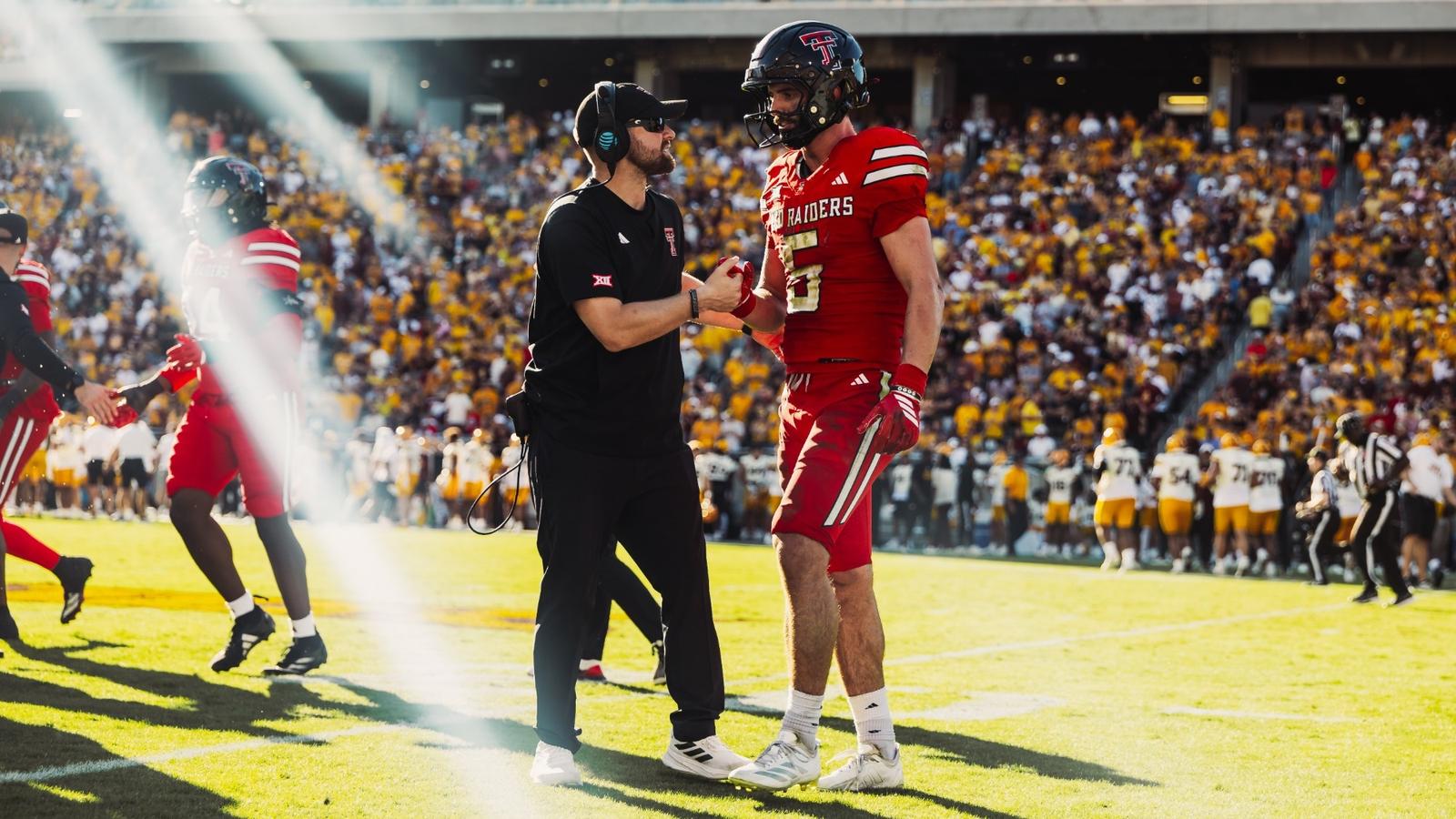
LUBBOCK, Texas – Texas Tech safeties coach Rob Greene was selected Monday to the AFCA 35 Under 35 Coaches Leadership Institute, one of college football’s prestigious programs designed to identify and develop future leaders in the coaching profession.
Greene has been invited to attend a one-day institute that features a curriculum of interactive lectures focused on topics specifically tailored to emphasize leadership in the coaching profession. The day-long session, which is hosted during the annual AFCA Convention, also includes sessions on ethics, influential responsibilities, career progression and family balance.
To be eligible, applicants must be 35 years old or younger on Jan. 1 of that year’s convention and must be currently serving as a high school head coach, a two-year college full-time assistant or head coach or an NAIA/NCAA (all divisions) full-time assistant or head coach. Applicants were required to submit a resume, five references, and a 1,600-word article or a 10-minute live instructional video on an offensive, defensive, special teams or position-specific topic of the applicant’s choosing back in the summer.
In only his first season, Greene has been an important part of Texas Tech’s defensive improvements under coordinator Shiel Wood. The Red Raiders are among the nation’s top defenses as the FBS leader for both rushing defense (68.5 yards allowed per game) and takeaways (31) to go along with a top-five ranking for both scoring defense (10.9 points allowed per game) and total defense (254.4 yards allowed per game).
In the secondary, the Red Raiders are giving up only 185.9 yards a game through the air, cutting down from 308.1 yards per contest in the year prior to Greene’s arrival. That average is currently on pace to be Texas Tech’s lowest since the Red Raiders surrendered only 182.4 passing yards a game in 2006. Texas Tech is already the nation’s most-improved defense in regards to scoring, going from 34.8 points allowed last season to only 10.9 this season.
Texas Tech’s defensive improvements have pushed the Red Raiders to possibly their best season in school history. The Red Raiders are currently 12-1 on the season heading into their first College Football Playoff appearance at the Capital One Orange Bowl.
Texas Tech enters the CFP having limited five of its last six opponents to single digits for points, with the most-recent occurrence being a 34-7 victory this past Saturday over BYU in the Edward Jones Big 12 Championship. It marked the first Big 12 title in school history for the Red Raiders, who will face the winner of No. 5 Oregon and No. 12 seed James Madison in the Orange Bowl.
Kickoff for the Orange Bowl is slated for 11 a.m. on Jan. 1 from Hard Rock Stadium in Miami. Coverage will be provided on ESPN and the Texas Tech Sports Network.
NIL
How Iowa State football should allocate its NIL budget – Iowa State Daily

Name, image and likeness, or NIL for short, has become a pivotal factor in recruiting and drawing in transfers in college football and will remain a factor whether fans like it or not.
The question is, how should Iowa State football spend its limited budget of money that can be given to players to try and draw them into its program?
Offense
I was having a conversation with my dad over the past weekend, and he said something that really stuck with me in regard to NIL. Allocating the NIL budget to an offensive line benefits every other offensive position.
As was said in the 1989 film “Field of Dreams,” “If you build it, he will come.”
In this scenario, “it” is a strong offensive line, and “he” is the other offensive skill positions.
A powerful offensive line provides more time in the pocket for a quarterback, which allows receivers and tight ends more time to get open and get the ball. This also boosts receivers’ and quarterbacks’ statistical numbers, which could bring those specific players NIL deals.
A powerful and dominant offensive line also allows running backs more holes, which would be really helpful for a team like Iowa State that has such a dominant recent history in the backfield.
The line also allows for some trickery, whether that be screen passes or designed quarterback runs.
Straying away from just the offensive line, star redshirt junior quarterback Rocco Becht will be coming into his senior season in 2026, assuming he decides to continue playing college football and not declare for the NFL draft.
That being said, the Cyclone coaching staff could consider approaching the transfer portal for a young quarterback to take the position held by players like Becht and former Cyclone quarterback Brock Purdy.
On the contrary, the current Cyclone quarterback room is strong with freshman quarterbacks like Connor Moberly and Alex Manske.
As for running backs, the Cyclones have a young core that shouldn’t need to be expanded on. Although Carson Hansen and Abu Sama III will be playing their senior season next year, there are proven young players in that running back room, like Aiden Flora and Dylan Lee.
And the same can be said for the receiver room. Redshirt junior wide receivers Xavier Townsend and Chase Sowell are going to be seniors next season, but I think that the offensive staff can put their trust in young players like redshirt freshman wide receiver Dominic Overby and sophomore wide receiver Brett Eskildsen.
Defense
Now I could make a similar argument to the offense, just pump money into the defensive line, but unfortunately, defense isn’t the same.
The defensive line will be hit by the end of this 2025 season, though. Senior defensive lineman Domonique Orange, who coined the nickname ‘Big Citrus’ by Cyclone fans, will be departing this season, as well as redshirt senior defensive linemen Tamatoa McDonough and Cannon Butler.
With big names like those three departing, it could be smart to try and bring in a big transfer player with a similar playstyle to the departing players.
As for linebackers, a player who some might have expected to have played his final season is redshirt senior linebacker Caleb Bacon, who broke the news that he will be returning in 2026, utilizing his medical redshirt.
With Bacon’s return, there are still linebackers like junior Kooper Ebel, sophomore Cael Brezina, redshirt junior Will McLaughlin and many more.
The Iowa State defense took a big hit in the 2024 season with multiple linebackers getting injured, so putting transfer money in for depth is always an option, but if it were up to me, the linebacker room is too good to try and bid for an expensive linebacker.
Finally, for the defensive backs, Jeremiah Cooper, a star corner for the Cyclones, played three games in 2025 before tearing his ACL, which resulted in a season-ending injury.
While Cooper should be eligible for a medical redshirt, he’s also been in 2026 NFL draft talks, so if he returns, it’s still up in the air.
How that affects the transfer portal, though, is the fact that once Cooper was injured, the defense felt it, so trying to spend heavily on a star defensive back like Cooper would be beneficial to the defense.
It would also be understandable if the staff strayed away from that. Young players like redshirt freshman defensive back Khijohnn Cummings-Coleman are young and skilled enough to play first-team reps, which could also help grow players like him into stars like Cooper.
Now, Iowa State doesn’t have the largest NIL budget in the world, meaning that not every hole that needs to be filled will be, but if the Cyclones can find the right players for the right prices, then Iowa State football should be a force to reckon with in the 2026 season.
NIL
ESPN predicts final score of every College Football Playoff game, National Championship
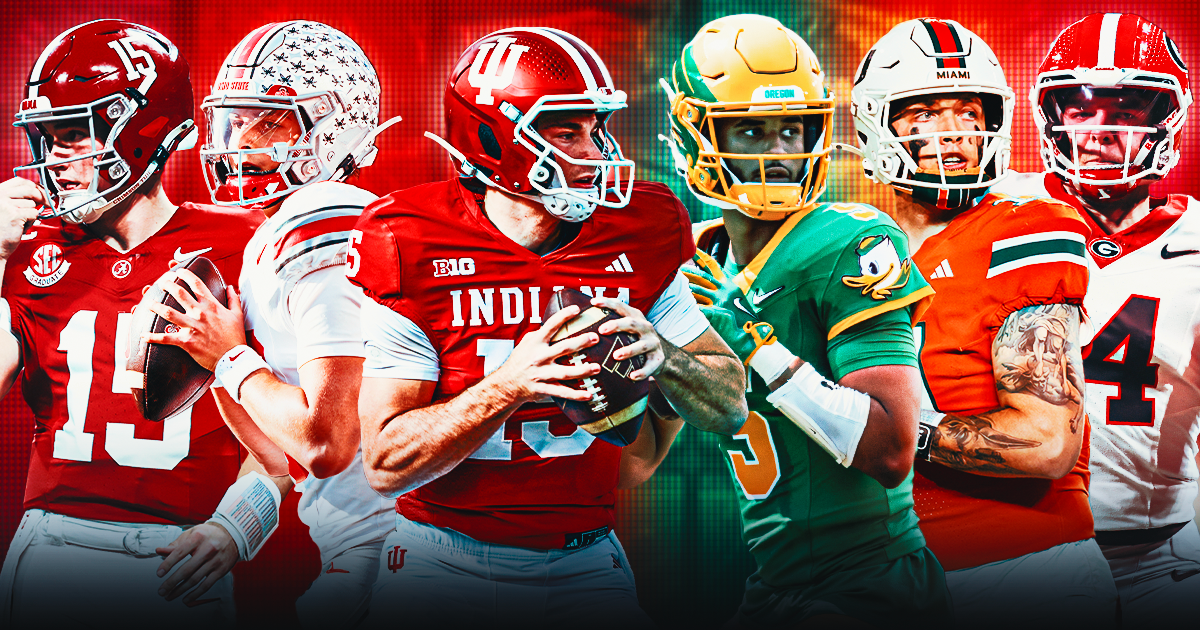
ESPN predicted the final score of every College Football Playoff game, including the national championship game. It’s a loaded bracket of 12 teams again and it should be a wild ride into January.
The first round games are on the campus of the higher seed. From there, games will be played at New Year’s Six locations before the finals in Miami.
Without further ado, let’s dive into the latest College Football Playoff predictions. Let’s fill out the bracket!
CFP First Round: No. 9 Alabama at No. 8 Oklahoma
Time: 8:00 p.m. ET on Dec. 19
Channel: ABC, ESPN
Location: Norman, Oklahoma
This College Football Playoff first round game is a rematch of a Sooners’ win earlier this year. Oklahoma stole a win 23-21 in Tuscaloosa the first time. Alabama is reeling a bit after losing 28-7 in the SEC Championship Game, but ESPN likes their chances the second time around.
Prediction Alabama 20, Oklahoma 17
CFP First Round: No. 10 Miami at No. 7 Texas A&M
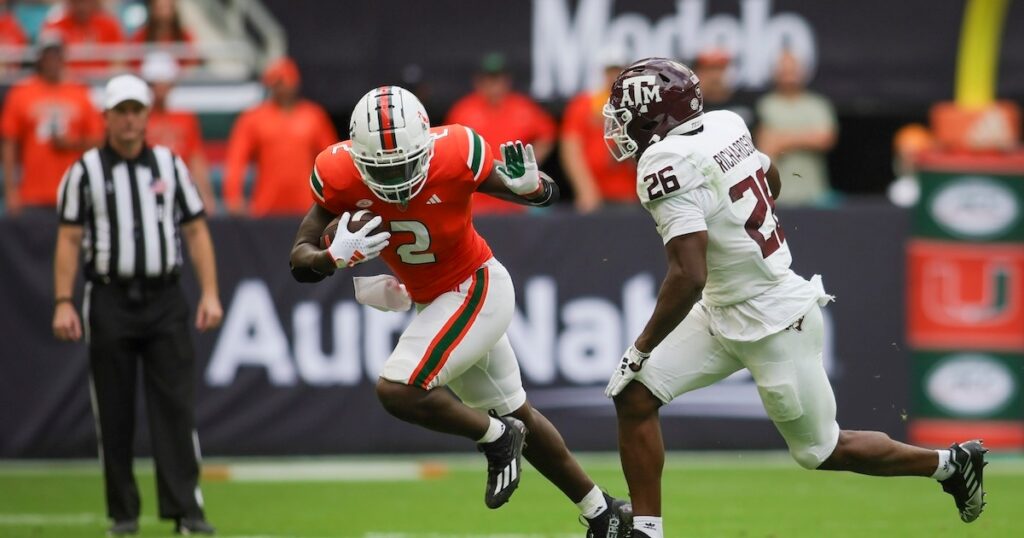
Time: 12:00 p.m. ET on Dec. 20
Channel: ABC/ESPN
Location: College Station, Texas
Texas A&M was last in action in a loss to Texas in the season finale. But, they still made the College Football Playoff for the first time. Miami got the final at-large bid and are hot after some less than stellar losses in or around midseason.
Prediction: Miami 31, Texas A&M 28
CFP First Round: No. 11 Tulane at No. 6 Ole Miss
Time: 3:30 p.m. ET on Dec. 20
Channel: TNT
Location: Oxford, Mississippi
Lane Kiffin is no more and Pete Golding is in! Ole Miss is in their first College Football playoff, as is Tulane. The Rebels blew the Green Wave out earlier this year, but this game should be more competitive in Jon Sumrall’s swan song before going to Florida. Still, there’s a gap between the two on paper.
Prediction: Ole Miss 34, Tulane 16
Time: 7:30 p.m. ET on Dec. 20
Channel: TNT
Location: Eugene, Oregon
For the first time, we’re getting two G5 teams in the College Football Playoff. There’s no question James Madison is a quality football team, but Oregon is a different beast. But, you have to play the game!
Prediction: Oregon 38, James Madison 13
CFP Quarterfinal at Cotton Bowl: No. 2 Ohio State vs. No. 10 Miami
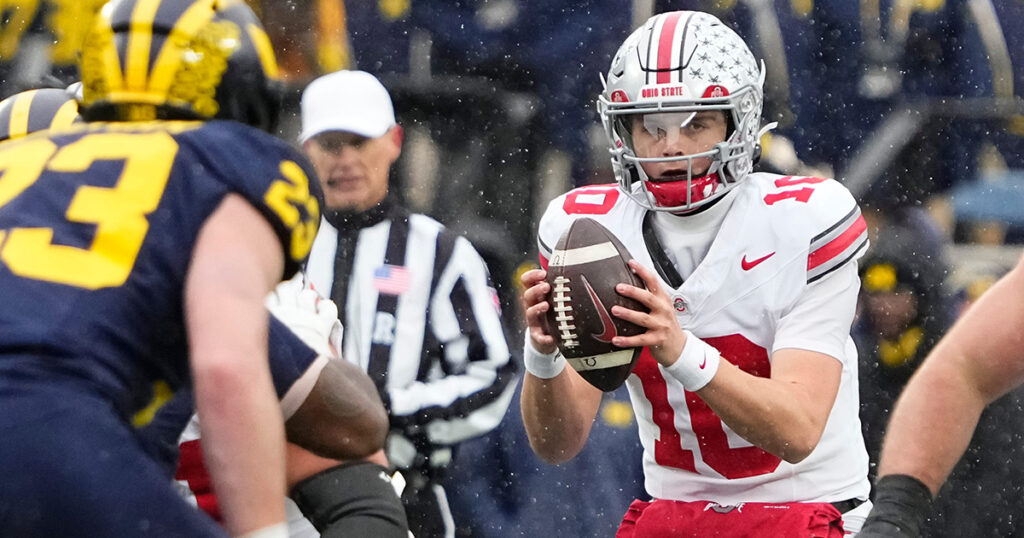
Time: 7:30 p.m. ET on Dec. 31
Channel: ESPN
Location: Arlington, Texas
Ohio State lost the Big Ten Championship but will be favored regardless of who they play here. Miami, in its first College Football Playoff, will have their run end here in heartbreaking fashion, per ESPN
Prediction: Ohio State 27, Miami 20
CFP Quarterfinal at Orange Bowl: No. 4 Texas Tech vs. No. 5 Oregon
Time: 12:00 p.m. ET on Jan. 1
Channel: ESPN
Location: Miami, Florida
Oregon went one and done in the College Football Playoff last year and some may think Texas Tech will do the same thing. Not so fast my friend! ESPN has the Red Raiders advancing by a hair.
Prediction: Texas Tech 23, Oregon 20
CFP Quarterfinal at Rose Bowl: No. 1 Indiana vs. No. 9 Alabama
Time: 4:00 p.m. ET on Jan. 1
Channel: ESPN
Location: Pasadena, California
If Alabama wins one College Football Playoff game, they can get hot and win a second right? Sure, but the Hoosiers are too good and went 13-0 for a reason. With elite defense and borderline elite QB play, IU is too much for Alabama. Try saying that a few years ago.
Prediction: Indiana 24, Alabama 16
CFP Quarterfinal at Sugar Bowl: No. 3 Georgia vs. No. 6 Ole Miss

Time: 8:00 p.m. ET on Jan. 1
Channel: ESPN
Location: New Orleans, Louisiana
Georgia will once again prove to be too much for Ole Miss, this time in a College Football Playoff setting. Pete Golding will have a good foundation for 2026, but Kirby Smart will be competing for a national title again this season.
Prediction: Georgia 31, Ole Miss 21
CFP Semifinal at Fiesta Bowl: No. 2 Ohio State vs. No. 3 Georgia
Time: 7:30 p.m. ET on Jan. 8
Channel: ESPN
Location: Glendale, Arizona
Ohio State and Georgia have some College Football Playoff history don’t they? Well, the Buckeyes get their time, again. This will be razor thin and ESPN predicts redemption for Buckeyes’ kicker Jayden Fielding!
Prediction: Ohio State 19, Georgia 16
CFP Semifinal at Peach Bowl: No. 1 Indiana vs. No. 4 Texas Tech
Time: 7:30 p.m. ET on Jan. 9
Channel: ESPN
Location: Atlanta, Georgia
The Red Raiders’ run in the College Football Playoff ends here. Curt Cignetti and crew will keep the perfect season going, improve to 15-0 and play for a title. But it won’t be easy against the Texas Tech defense.
Prediction: Indiana 20, Texas Tech 17
CFP National Championship: No. 1 Indiana vs. No. 2 Ohio State
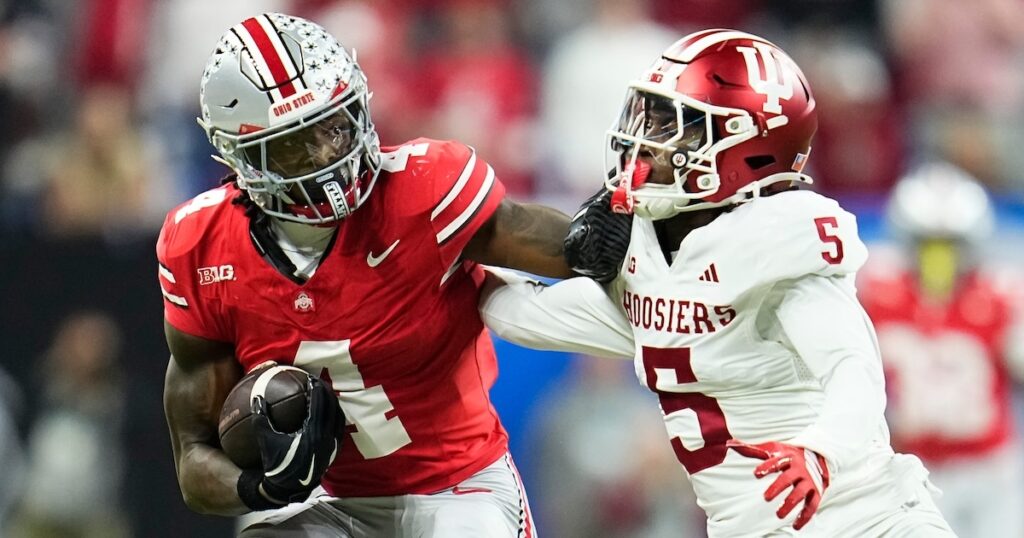
Time: 7:45 p.m. ET on Jan. 19
Channel: ESPN
Location: Miami, Florida
This will be an all-Big Ten College Football Playoff title game. But this time, Ohio State gets the win in the rematch. It won’t be high scoring, but ESPN is banking on Jeremiah Smith being the difference maker this time around. Back to back folks.
Prediction: Ohio State 24, Indiana 20
NIL
Kentucky’s $22 Million Basketball Roster Looks Like a Dud
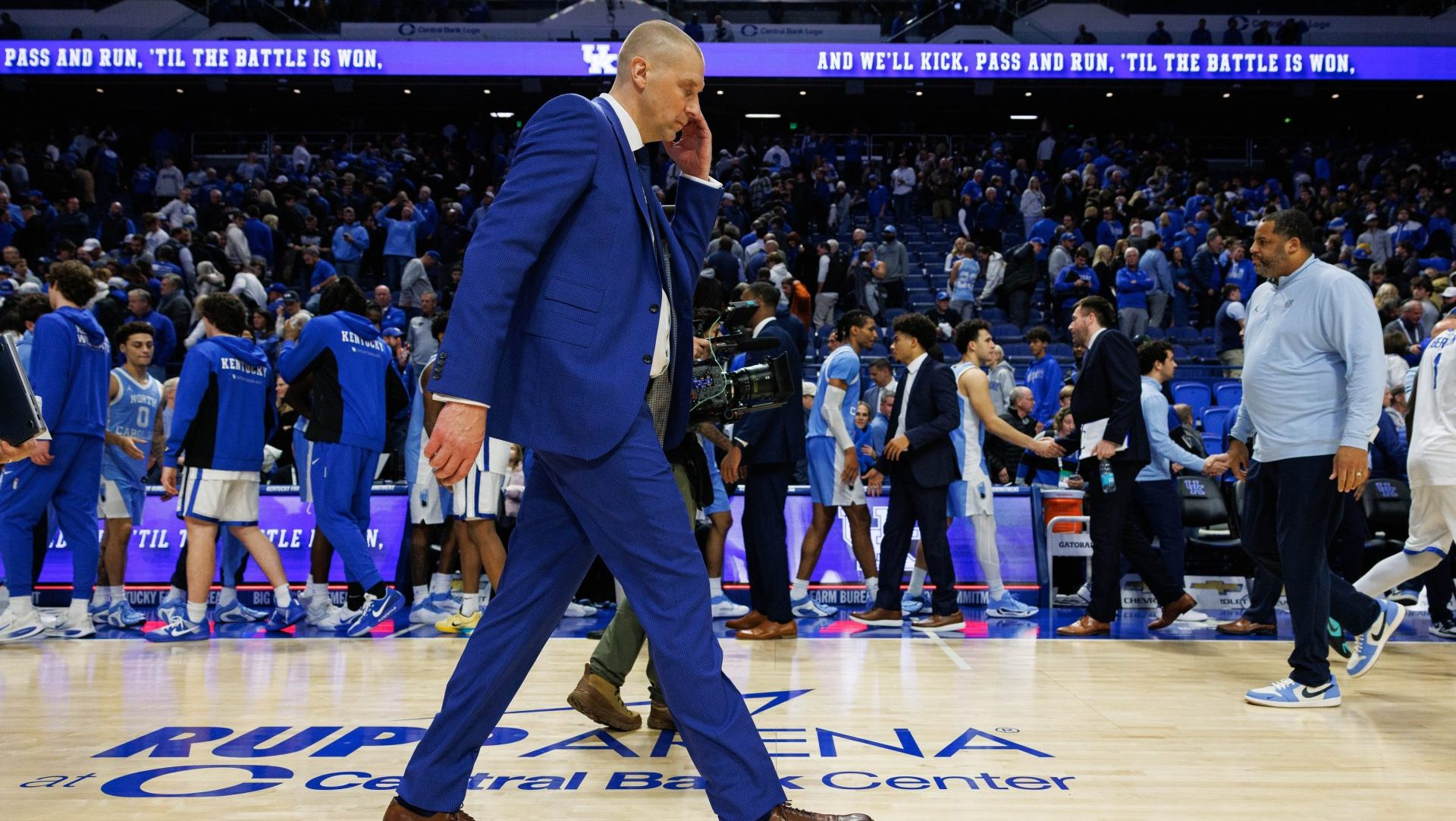
-

 Rec Sports2 weeks ago
Rec Sports2 weeks agoFirst Tee Winter Registration is open
-

 Rec Sports2 weeks ago
Rec Sports2 weeks agoFargo girl, 13, dies after collapsing during school basketball game – Grand Forks Herald
-

 Motorsports2 weeks ago
Motorsports2 weeks agoCPG Brands Like Allegra Are Betting on F1 for the First Time
-

 Sports3 weeks ago
Sports3 weeks agoVolleyball Recaps – November 18
-

 Motorsports2 weeks ago
Motorsports2 weeks agoF1 Las Vegas: Verstappen win, Norris and Piastri DQ tighten 2025 title fight
-

 Sports2 weeks ago
Sports2 weeks agoTwo Pro Volleyball Leagues Serve Up Plans for Minnesota Teams
-

 Sports2 weeks ago
Sports2 weeks agoUtah State Announces 2025-26 Indoor Track & Field Schedule
-

 Sports2 weeks ago
Sports2 weeks agoSycamores unveil 2026 track and field schedule
-

 Motorsports2 weeks ago
Motorsports2 weeks agoRedemption Means First Pro Stock World Championship for Dallas Glenn
-

 NIL1 week ago
NIL1 week agoBowl Projections: ESPN predicts 12-team College Football Playoff bracket, full bowl slate after Week 14























































